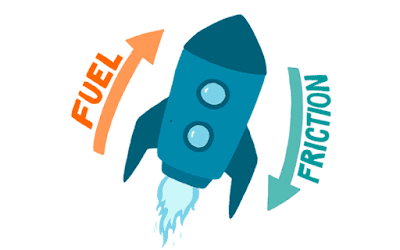I was recently turned on to a podcast called the Hidden Brain where they explore the unconscious patterns that drive human behavior and questions that lie at the heart of our complex and changing world. It is a fascinating podcast where a variety of experts talk about the human brain and how we react to the multiple variables around us. In one particular episode (Work 2.0: The Obstacles You Don't See), the topic was fuel vs. friction and a number of examples were shared where companies/organizations were trying to market their products and weren't seeing success in selling them. In the podcast, Northwestern University Organizational Psychologist, Loren Nordgren, speaks to the fact that Most of us think the best way to win people over is to push harder, but a more effective approach is to focus on the invisible obstacles to new ideas. In one particular case, he discusses a furniture company that was targeted towards millennials and let them design their ideal piece of furniture (design, fabric, shape, etc.) because it was more than likely the first element of furniture they would purchase as an adult. They saw a great deal of customers come in and design a piece, but they would never make it to the act of purchasing. The company thought about fueling their approach by lowering prices, changing the customer experience, and modifying their marketing scheme but in the end, they realized that none of that worked. Instead, all they needed to do was remove a friction point (e.g. helping people figure out how to remove their old furniture from their homes) to have their business blow up and increase sales.
As I thought about this idea of fuel vs. friction, it dawned on me that in schools we sometimes focus our efforts too much on the fuel rather than the friction, when in all honesty, if we spent just a little time looking at the friction points, we might be able to make some significant gains. If we can identify friction at both the organizational and individual levels, we might have better school cultures and also find more joy and fulfillment in what we do on a daily basis. We just need to shift our mindsets and ask the really important questions about what friction points are preventing us from moving forward rather than what new things we can do to fuel our growth. It's a difficult process to go through because when we focus on friction, we have to take a long, hard look at ourselves in the mirror and determine what we can cut out. We have to be willing to not point fingers and cast blame on one another for why we find ourselves at this point and choose to focus on improvement. That's a really tough thing to do when our natural tendency is to blame and provide excuses.
So what are the friction points? From a 30,000 foot view, I think that most schools would identify teacher burnout, student attendance, and social/emotional well being as three pretty big obstacles that are causing a significant amount of friction right now. These are big issues that are not going away any time soon. The answer to them will not be found in fueling new marketing campaigns, pep rallies, or incentives. Instead, it is going to require tough, laborious work mixed in with difficult conversations centered on strong relationships. It's going to take everyone involved to set aside their excuses and blame so that positive, productive, and honest conversations can be had. The solution is out there, but we have to put the work in to find it. For those of you looking for an answer in this blog, you came to the wrong place because the answer will not be found with one person or leader, but rather, a collective group that is tired of talking around the issues and coming together to remove the friction.
#FORWARD #FORGE




